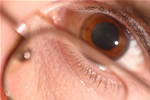
 Diabetes and the Eye
Diabetes and the Eye
Diabetes can affect the eyes in different ways, from mild temporary effects to more severe complications that can lead to blindness. Complications are more likely in those who have been diabetic for many years. Because a person may have diabetes without knowing it, many times changes in vision may be the first sign.
Blurred vision is the most common effect of diabetes. This is caused by changing glucose levels affecting the balance of fluid in the lens of the eye. The lens works like a camera lens to focus images on the retina. As the lens absorbs more water than normal, it swells and the focusing power changes. When a diabetic’s blood glucose is unstable, the vision will also be unstable.
Cataracts are a clouding of the lens of the eye. Although cataracts are a normal aging process, diabetics are 60% more likely to develop cataracts at a younger age and have them progress at a faster rate. Diabetic cataracts form by the same pathway discussed above. As the lens swells and shrinks with fluctuating glucose levels, cracks and opacities develop in the lens and block light from reaching the retina.
Diabetic retinopathy is a general term for all disorders of the retina caused by diabetes. The retina is the tissue in the back of the eye that acts like camera film. The retina is full of blood vessels. These blood vessels can swell and leak fluid, causing blurred vision. If the blood vessels become more damaged, they can close off and prevent blood flow to peripheral areas of the retina. If this happens, new blood vessels may start growing to compensate. These new vessels are much weaker and can leak blood into the vitreous, blocking vision or causing scar tissue to grow. As the scar tissue shrinks, the retina may become detached from the eye and vision lost.
Glaucoma is a sight-threatening disease that can occur as a result of diabetes, most commonly from new vessel growth from the retina onto the iris (colored portion of the eye) blocking fluid outflow from the eye. As the fluid builds up in the eye, the pressure in the eye increases and causes damage to the optic nerve and loss of peripheral vision occurs.
Most diabetics have nothing more than minor eye disorders, but they have a higher risk of blindness than people without diabetes. Yearly eye examinations with dilated pupils allow the eye care practitioner to notice changes early and implement treatment before serious complications occur.